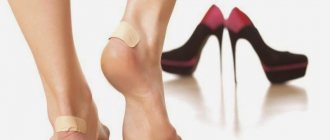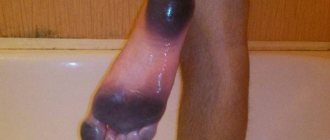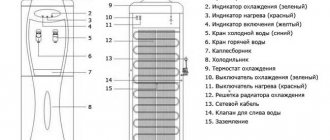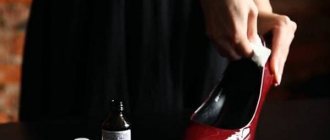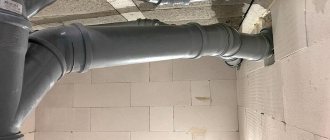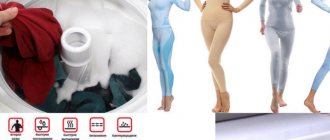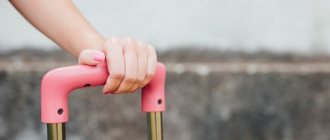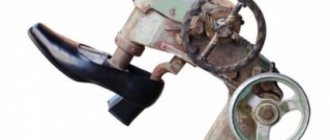Home page » Home and comfort » Wardrobe care
Author of the article
Svetlana Pavlikhina
Reading time: 6 minutes
AA
It often happens that when trying on shoes in a store, no discomfort is noted, and they fit just perfectly. But the first time you go outside, it becomes clear that your new shoes are rubbing your heel.
It’s worth figuring out why this is happening and whether there is a way to solve the problem.
Why you can't tolerate tight shoes
Many people believe that tight shoes are a temporary phenomenon, and the heel will wear out a little over time and become softer. But there is no guarantee that this will happen. It is quite possible that even after prolonged wear it will remain stiff at the back.
The following problems may arise:
- foot deformity;
- severe pain in the legs;
- the appearance of blisters;
- addition of infection.
Therefore, you should not allow your shoes to rub your feet. Otherwise, you will have to think about how to treat the affected skin. This is a much more difficult task.
Dealing with the consequences
My shoes rub my heels, what should I do? There are two sides to the problem. In parallel with breaking in, you need to worry about the legs, which have already suffered. It is not always possible to protect yourself from the appearance of calluses in a timely manner. If it has already appeared, then first of all we change the pair to a familiar and comfortable one. And we use it until the wound heals.
Wet blisters
The so-called dropsy is very painful, so the bactericidal patch should protect the neoplasm from exposure. Do not try to pierce it, to avoid the risk of infection. To speed up regeneration processes, use freshly cut aloe or plantain to prepare a compress.
The healing of dropsy is a long process and requires special actions:
- Iodine, brilliant green, peroxide are used for disinfection in the wound area.
- We prepare a bath and disinfect the sewing needle in it for 5 minutes.
- We heat the bubble on several sides to drain the exudate. Punctures are made parallel to the skin.
- There is no need to tear off the skin of the bladder; it will act as protection for the wound during the healing process.
- Apply antibacterial ointment and cover with a bactericidal plaster.
Correctly carried out actions minimize the risk of infection of the wound surface. In the future, the bandage must be changed every 5 hours.
Dry corns
The skin's response to constant pressure is its hardening. Dry calluses appear in such places. They get rid of them with baths and compresses using potassium permanganate and chamomile decoction. The temperature of the prepared solution should be within 40 degrees.
How to prevent calluses
New shoes rub your skin - how to get rid of this problem? Only ideally selected shoes and their correct placement can serve as a guarantee. The correct size and comfortable last is reinforced by gluing a bactericidal patch to critical areas of the foot.
Why does the heel rub?
There are several reasons:
- Wrong size selected. Tight shoes or boots squeeze the foot, and too loose ones rub the skin. Because of this, irritation is noted and calluses appear.
- Rough material. A hard heel will inevitably rub your heel.
- The model is not chosen for the leg. Everyone's feet are different - narrow or wide, and not every option may be suitable.
Swelling of the legs. Changes in foot size throughout the day due to swelling cause calluses to appear on the feet.- Sewing defects, for example, rough seams on the back.
- Individual characteristics. Often the problem occurs after a heel fracture or other injury.
We choose wisely
Responsibility and balance are the main criteria for approaching selection and fitting, so as not to look for an answer to the question “Shoes rub your heels, what should I do?” Most of the purchased models are intended for frequent use. Comfort is the main point in the choice, after which we pay attention to beauty and other features. If boots rub your heel, then no matter how beautiful they are, they turn into an instrument of torture. Advice for a specific case is complex, but there are general recommendations that you need to heed so as not to torment your feet with shoes:
- Walk around in the product you like right in the store, this will allow you to feel it.
- Even if you really like the model, but the size is a little larger, don’t buy it - the backs will bother you.
- Look for an orthopedic last - one of the defining moments.
- Natural material is preferable.
- Time for shopping is also important. It is necessary to measure in the evening, by this time the leg becomes a little larger.
- Avoid hard soles, opting for soft and flexible bases.
It is not always possible to wear shoes. The reason may be the peculiarity of the material from which it is made, as well as natural factors - a slight increase in the size of the leg in the afternoon. Soft natural materials may stretch a little when trying them on, but the size is still not yours, you need to take this into account.
What do you do with your shoes if the heel rubs?
How to soften the heels of shoes
Most often, calluses appear due to wearing new shoes. There are several methods to solve this problem.
You need to consider what material the shoes are made of.
Leather shoes
The following methods will help you break in shoes and make the heel softer:
- Wool socks. They need to be soaked in hot water, wrung out, and put on your feet. Put on your shoes, walk around the apartment. When the socks are dry, you can take off your shoes. Under the influence of moisture and heat, the backdrop expands slightly and softens.
- Alcohol. Socks are soaked in it. The principle of operation is the same as with water, but the desired result will be faster.
- Night stretching. After breaking in the shoes, socks should be left in the shoes. Also, the shoes need to be tightly stuffed with crumpled paper. They are left in this state overnight.
- Mechanical softening. The backdrop is wrapped in fabric and tapped with a hammer. It is also possible to compress the material with pliers.
Special means. There are many creams, sprays, and foams on sale that are designed to stretch the skin. The size will not increase when using them, but the back will become softer.- Castor oil or glycerin. The product is rubbed in using a tampon. After a few minutes, the shoes are polished.
- Vinegar. Wipe the inside of the shoes with the liquid. The product is left to dry completely.
If the shoes are made of leatherette
The following means are used:
- Vegetable oil. They generously treat the inside of the shoe. After a quarter of an hour, excess oil is removed with a napkin.
- Alcohol solution. Alcohol is mixed with water in equal proportions. The resulting liquid is used to treat the backdrop.
- Liquid soap. Apply it to the surface and wait a few minutes. Then the surface is polished.
If the boots are pressing
Not all methods are suitable for stretching boots. It is much more difficult to soften such shoes, so special products are used.
Pencil
The product helps soften backdrops. With its help, it is possible to protect the heel from further rubbing.
After treatment with a pencil, shoes on the inside become smooth and do not have a negative effect on the skin. There are no marks left on tights or socks, as well as on the shoes themselves.
Band-Aid
It is glued not only to the heel, but also to the heel. But when walking, sometimes the patch often comes off and becomes crumpled. Because of this, the legs suffer more. Therefore, this method should be used in exceptional cases.
Silicone pads
Silicone shoe inserts help avoid chafing. They are fixed in places of high pressure. Additionally, an adhesive plaster is used.
Patches and gaskets
If the cause of chafing is a hard seam, this method will help eliminate the problem. The seam should be covered with a soft cloth.
The patch should be sewn to the backdrop or glued. However, this option is not suitable if the shoes are very tight.
Sports shoes rub the heel
If your sneakers start to chafe, the following method will help:
A towel or regular cloth is soaked in hot water.- Excess liquid is squeezed out.
- The wet material is placed in the sneakers.
- After three hours you need to put on thick socks and shoes.
- Walk for about half an hour.
It is worth noting that this method is not always allowed. For example, if vans or boots are equipped with a cardboard back, moisture will harm them.
If the boots have been left unattended for a long time, the material dries out and they begin to chafe. To soften them, you need to apply baby cream to the back and leave to soak in overnight.
Removing blisters
Shoes are rubbing on the heel - what to do? Reviews from experts do not recommend piercing calluses that appear. Again, a contrast bath will help to cope with blisters. After it, it is recommended to lubricate the blister on the leg with pharmaceutical ointment, which includes an antibiotic. The damaged area should then be covered with adhesive tape.
To remove calluses, you can also use drying creams and gels. They must contain zinc. This treatment procedure is best done before bedtime. First you need to wash your feet, then apply ointment to the callus and cover the damaged area of skin with a gauze bandage. In the morning, remove the compress and apply a rich cream to your leg.
How to soften children's shoes
Children's shoes deserve special attention. She can also rub. The problem must be resolved without delay. It is unacceptable for calluses to appear on the baby's delicate skin .
Leather
First of all, it is worth noting that regardless of the chosen stretching method, the skin loses fat and becomes brittle. Therefore, after performing the procedure, it must be treated with conditioner or shoe polish.
A regular hairdryer will help. With its help, the skin warms up. After this, you need to put on your shoes and walk around in them a little. These steps are repeated until the product takes the desired shape.
It is worth considering that it is impossible to warm up the glued areas.
You can stretch children's shoes without the baby's participation using the freezing method:
- The bag, made of thick polyethylene, is filled with water and tied.
- It is placed in the shoe.
- The shoes are sent to the freezer.
- When the water turns into ice, the product is removed from the freezer.
- Wait until the ice melts a little.
- Remove the package.
Nubuck or suede
Suede is very capricious, but it stretches well, so you shouldn’t put much effort into stretching it.
To do this, an adult only needs to wear tight shoes at home for a few days, and after that they will fit perfectly on their feet. But this option is not suitable for children.
To stretch boots made of nubuck or suede, it is recommended to use a special spray. It is sprayed on the inside of the product, the shoes are put on and worn until they are completely dry.
You can spray the product with steam and walk around the house in it. This method is also suitable for stretching beach shoes with a fixed heel, sandals, sandals.
Rubber boots
If the boots are made of regular rubber, it is impossible to stretch them. Another thing is models made of polyvinyl chloride. This material is often used to make waterproof shoes for children.
To achieve a good result, you just need to perform a few steps:
- Pour boiling water into the boots.
- Wait 5-10 minutes.
- Drain the water.
- Put boots on your feet. You can enhance the effect by wearing several socks.
- Place your feet and boots in a container of cold water. The material quickly hardens and takes on the desired shape.
When the callus is already there
Did you rub your heel with your shoes? What to do, how to treat the leg in such a situation? If calluses or even blisters appear, you should not neglect this. Otherwise, the neglected problem will lead to more serious consequences.
Contrast baths help relieve pain, relieve itching and burning. Warm, cool water will help deal with the problem even faster if you add chamomile, calendula, nettle or burdock to it. All of these plants have antiseptic effects, heal and soothe the damaged area.
After the procedure, you will need to wipe your feet dry and, using a special fatty cream, apply to the rubbed area of skin.
Shoemaker tips
To wear shoes without damaging the product, you need to follow the recommendations of professionals:
. To do this, a small amount of the substance is applied to an inconspicuous area of the product. The procedure is allowed only if there are no negative changes.
Regardless of which product you choose, you should make sure it is safe- It is permissible to use special products only when stretching natural leather. The artificial material will deteriorate under their influence.
- Patent leather shoes should not be doused with boiling water or placed in the freezer.
- When using a hair dryer, it is recommended to cover the material with a damp cloth. Due to this, it is possible to prevent the material from drying out.
- When using a hammer to soften it, it is important not to overdo it. Rigidity must be maintained, otherwise the shoes will become shapeless and even more uncomfortable.
The best and safest way to solve the problem is to seek help from professionals. An experienced shoemaker will be able to do the job efficiently without harming the material. It has all the necessary accessories to soften the backdrop.
